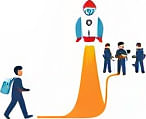Scaling Freelance Services into Profitable Products
 by Lilian Nienow
by Lilian Nienow
Transitioning from freelance work to creating marketable products offers freelancers a path to business independence and growth. This article explores practical steps, from identifying opportunities to launching successfully, motivating aspiring entrepreneurs to take control of their careers.

Freelancers often start with offering services based on their skills, but turning those into products can lead to greater stability and income. Many begin by selling time and expertise, yet packaging this into repeatable offerings changes the dynamic.
The Appeal of Products from Services
Creating products from freelance services allows for passive income streams. For instance, a graphic designer might develop templates that clients can purchase repeatedly. This shift means less dependency on individual projects and more scalable revenue.
One key advantage is reaching a wider audience. products like online courses or digital tools can be sold globally without the need for one-on-one interactions. This expansion helps build a brand that stands on its own.
Identifying Opportunities
To begin, assess your current services and find elements that can be standardized. A freelance writer, for example, could compile articles into an e-book. Look for patterns in client requests to pinpoint what has consistent demand.
Market validation is essential here. Gather feedback through surveys or prototypes to ensure your idea meets needs. Once validated, focus on development to refine the offering.
Development and Launch Steps
Start with planning the product lifecycle. For a web developer, turning custom code into a plugin involves outlining features and testing for usability. Use tools to streamline creation, ensuring the end result is polished.
Building a minimum viable product, or MVP, is a practical approach. This version includes core functions to test the market without over-investing. After launch, iterate based on user input to improve and expand.
Marketing plays a crucial role. Share your product on platforms where your audience gathers, such as social media or industry forums. Create content that highlights benefits to attract potential buyers.
Overcoming Common Hurdles
Freelancers may face challenges like time management when balancing service work and product development. Prioritize tasks by setting clear goals and deadlines. Funding can also be an issue, so explore options like bootstrapping or small investments from supporters.
Competition is another factor. Differentiate your products by emphasizing unique aspects, such as personalized support or innovative features. Learning from setbacks builds resilience and informs future efforts.
Realizing Long-Term Growth
As your product gains traction, consider scaling further. This might involve hiring help or automating processes to handle increased demand. Tracking metrics like sales and engagement provides insights for adjustments.
For freelancers aiming for independence, this transition fosters a sense of ownership. Success stories, like a consultant turning advice into a subscription service, show the potential rewards.
Practical Tips for Aspiring Entrepreneurs
- Conduct thorough research on your target market.
- Build a simple business plan to guide your efforts.
- Network with others who have made similar shifts for advice.
- Stay adaptable to changes in trends and feedback.
In summary, moving from services to products requires effort but offers substantial benefits. It empowers freelancers to create sustainable businesses and achieve greater autonomy.
